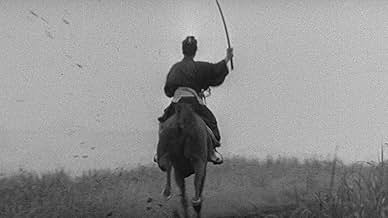CALIFICACIÓN DE IMDb
7.5/10
3.2 k
TU CALIFICACIÓN
Agrega una trama en tu idiomaAfter killing a counselor of his clan, a fugitive samurai befriends a couple poaching the shogun's gold in the mountains.After killing a counselor of his clan, a fugitive samurai befriends a couple poaching the shogun's gold in the mountains.After killing a counselor of his clan, a fugitive samurai befriends a couple poaching the shogun's gold in the mountains.
- Dirección
- Guionistas
- Elenco
- Dirección
- Guionistas
- Todo el elenco y el equipo
- Producción, taquilla y más en IMDbPro
Argumento
¿Sabías que…?
- TriviaThis film is part of the Criterion Collection, spine #311.
- Citas
Minister: Wait! We're not connected at all. Why kill me?
Yuuki Gennosuke: No, we *are* connected because I'll see you in hell.
- ConexionesFeatured in Best in Action: 1965 (2021)
Opinión destacada
There are many films set in the feudal period of Japan that can be read as commentary on contemporary Japanese life. Here a couple of well-meaning and excellent sword-fighters are used by their superiors to further selfish agendas. The "beast" of the title is not a crazy samurai but rather the noble hero who is forced by treachery to forgo his social connections and travel from place to place like a roaming beast.
As western values permeate Japan, the conflict between the individual, as personified by the wandering noble ronin who gives up attempting to reconnect with normalcy (or in American cinema, the western hero who rises above social norm and becomes an ideal to attain), and the good samurai who upholds social stability to the detriment of his own needs (no real American equivalent) found itself expressed in period Japanese films. Many Japanese films of the 1960's and 70's feature characters who reject old fashioned values in the name of justice, yet suffer and never really are able to enjoy their good deeds. This film is set in the time after Commander Perry's ships essentially invaded Japanese territory and threw Japanese society for a spin.
Well-made, good acting and a solid directorial effort makes this a good samurai film even if the repeated flash-backs might be confusing. Unfortunately there are some excellent films that cover this topic already so this particular film seems unremarkable by comparison.
Good film and recommended.
As western values permeate Japan, the conflict between the individual, as personified by the wandering noble ronin who gives up attempting to reconnect with normalcy (or in American cinema, the western hero who rises above social norm and becomes an ideal to attain), and the good samurai who upholds social stability to the detriment of his own needs (no real American equivalent) found itself expressed in period Japanese films. Many Japanese films of the 1960's and 70's feature characters who reject old fashioned values in the name of justice, yet suffer and never really are able to enjoy their good deeds. This film is set in the time after Commander Perry's ships essentially invaded Japanese territory and threw Japanese society for a spin.
Well-made, good acting and a solid directorial effort makes this a good samurai film even if the repeated flash-backs might be confusing. Unfortunately there are some excellent films that cover this topic already so this particular film seems unremarkable by comparison.
Good film and recommended.
- ChungMo
- 26 oct 2007
- Enlace permanente
Selecciones populares
Inicia sesión para calificar y agrega a la lista de videos para obtener recomendaciones personalizadas
- How long is Sword of the Beast?Con tecnología de Alexa
Detalles
- Tiempo de ejecución1 hora 25 minutos
- Color
- Mezcla de sonido
- Relación de aspecto
- 2.35 : 1
Contribuir a esta página
Sugiere una edición o agrega el contenido que falta

Principales brechas de datos
By what name was Kedamono no ken (1965) officially released in India in English?
Responda

























